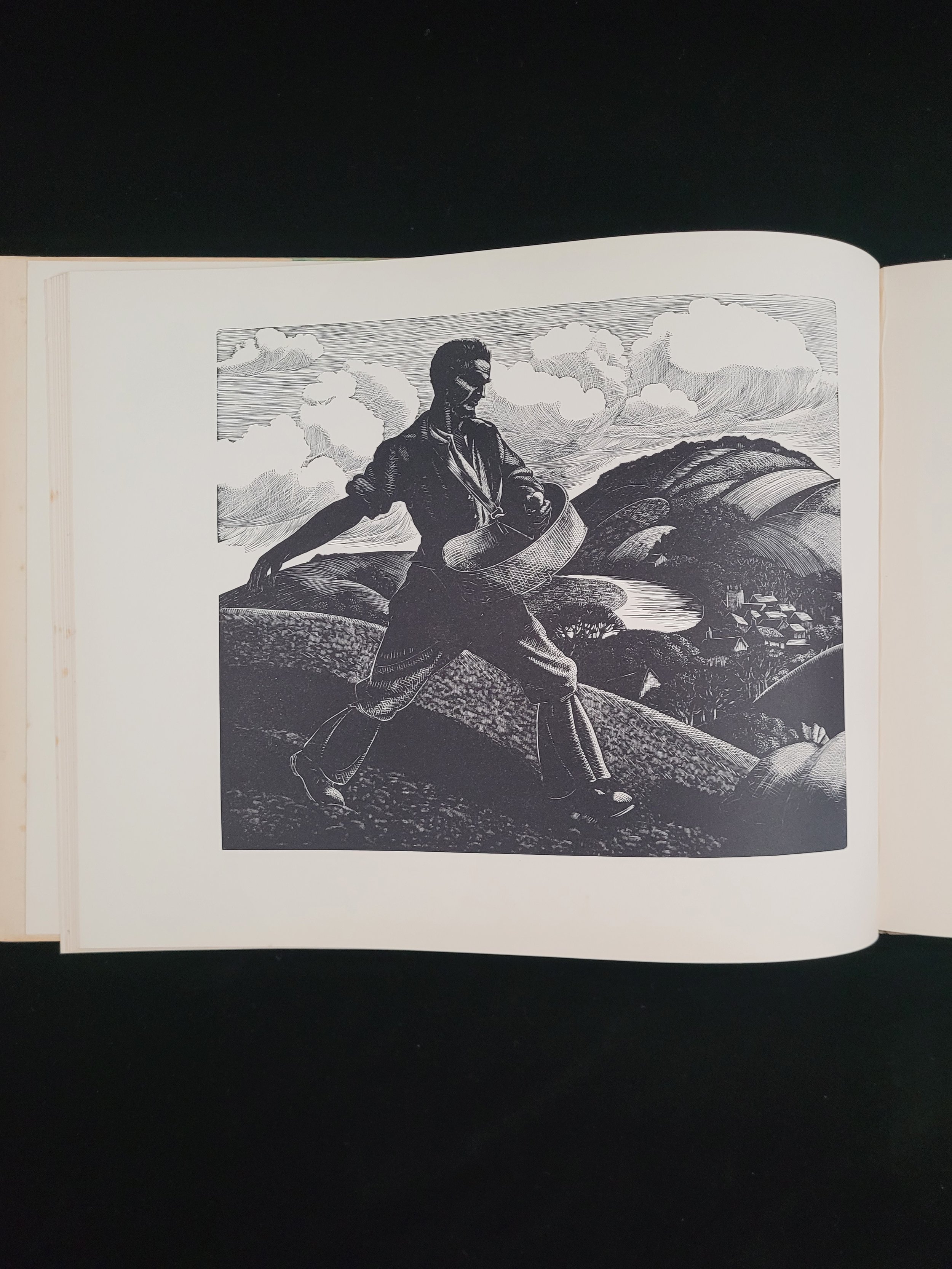 Image 1 of 5
Image 1 of 5

 Image 2 of 5
Image 2 of 5

 Image 3 of 5
Image 3 of 5

 Image 4 of 5
Image 4 of 5

 Image 5 of 5
Image 5 of 5






The Farmer's Year
LEIGHTON, Clare. The Farmer’s Year.
London: Collins, 1933
Oblong 8vo., original bright green publisher’s cloth, lettered in gilt to upper board and along spine, with upper board repeating, in gilt, the title vignette of a farmer carrying a scythe on his back; illustrative endpapers; in matching unclipped dust jacket (10/6 net), printed in green; pp. [x], 3-54, [ii]; with 12 full-page wood engravings, 7 tail pieces and one vignette to title; boards sunned and discoloured to edges, with some light rubbing and a couple of spots; with some light spotting also affecting the outer edge and prelims; endpapers a trifle mottled; else internally one of the cleaner copies we have seen; in the very good dust jacket which is evenly toned, slightly spotted, particularly so to the front flap, and rubbed to extremities; a couple of small nicks internally reinforced with tape.
First edition, first printing, in the original dust jacket.
Clare Leighton (1898-1989) was an American writer and wood engraver who was first encouraged to draw by her father and uncle, the latter taking her on many sketching trips throughout Europe in her formative years. After completing her studies at Brighton College of Art and the Slade, Leighton spent a period of time in Italy, France and the Balkans, where she developed a close affinity with rural life, and in particular peasant workers who dotted the landscape and countryside of her travels. Many of her books and illustrations from that point onwards were dedicated to this very subject - the people who worked the land despite a changing and ever-developing mechanisation and urbanisation of the environment.
In 1932, Leighton published Wood-Engravings and Woodcuts, the first book of its kind to be produced by a woman, and it was this work which played a key role in popularising the medium as an art form. It is perhaps The Farmer’s Year, though, for which she is best remembered today. Leighton lived among the workers of Buckinghamshire for many months while she researched and drew the activities in their day-to-day lives, and the breathtaking and highly emotive full-page engravings depict the full scope of husbandry over twelve months, including Lambing, Sowing, Hay-Making, Harvesting, Cider-Making and Ploughing. The work remains a beautiful record of English farming shortly before the Second World War dramatically changed the nature of the industry for good.
First impression copies in the unclipped dust jacket are becoming more and more scarce.
LEIGHTON, Clare. The Farmer’s Year.
London: Collins, 1933
Oblong 8vo., original bright green publisher’s cloth, lettered in gilt to upper board and along spine, with upper board repeating, in gilt, the title vignette of a farmer carrying a scythe on his back; illustrative endpapers; in matching unclipped dust jacket (10/6 net), printed in green; pp. [x], 3-54, [ii]; with 12 full-page wood engravings, 7 tail pieces and one vignette to title; boards sunned and discoloured to edges, with some light rubbing and a couple of spots; with some light spotting also affecting the outer edge and prelims; endpapers a trifle mottled; else internally one of the cleaner copies we have seen; in the very good dust jacket which is evenly toned, slightly spotted, particularly so to the front flap, and rubbed to extremities; a couple of small nicks internally reinforced with tape.
First edition, first printing, in the original dust jacket.
Clare Leighton (1898-1989) was an American writer and wood engraver who was first encouraged to draw by her father and uncle, the latter taking her on many sketching trips throughout Europe in her formative years. After completing her studies at Brighton College of Art and the Slade, Leighton spent a period of time in Italy, France and the Balkans, where she developed a close affinity with rural life, and in particular peasant workers who dotted the landscape and countryside of her travels. Many of her books and illustrations from that point onwards were dedicated to this very subject - the people who worked the land despite a changing and ever-developing mechanisation and urbanisation of the environment.
In 1932, Leighton published Wood-Engravings and Woodcuts, the first book of its kind to be produced by a woman, and it was this work which played a key role in popularising the medium as an art form. It is perhaps The Farmer’s Year, though, for which she is best remembered today. Leighton lived among the workers of Buckinghamshire for many months while she researched and drew the activities in their day-to-day lives, and the breathtaking and highly emotive full-page engravings depict the full scope of husbandry over twelve months, including Lambing, Sowing, Hay-Making, Harvesting, Cider-Making and Ploughing. The work remains a beautiful record of English farming shortly before the Second World War dramatically changed the nature of the industry for good.
First impression copies in the unclipped dust jacket are becoming more and more scarce.

